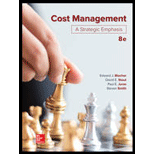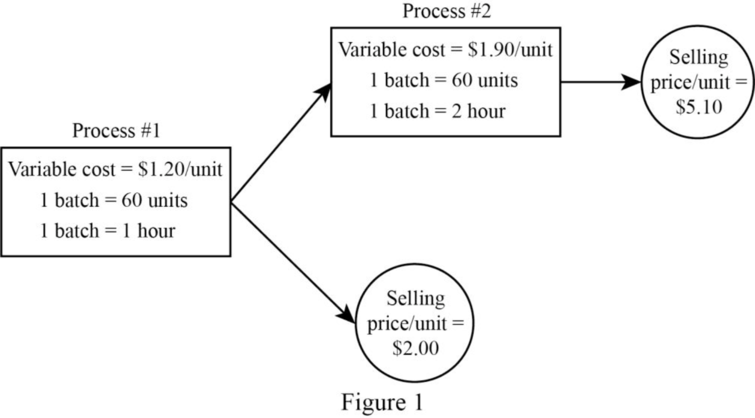
1.
Develop a schematic diagram of the two-stage production process.
1.
Explanation of Solution
Develop a schematic diagram of the two-stage production process:

Figure (1)
Note: In this case, the manufacturing overhead is entirely fixed, as such; hence it is considered a sunk cost with respect to the sell-or-process-further decision.
2.
Compute the following:
- a. Contribution margin per hour for output from Process 1.
- b. Contribution margin per hour for output from Process 2.
- c. The implication of the given information, if the goal of the company is to maximize shorttermoperating income.
2.
Explanation of Solution
In this case, the number of processing hours (Scarce resource)is limited,so the short-term objective would be to maximize the contribution margin per hour of processing time. Contribution margin per hour for output from Process 1 and Process 2 are as follows:
| Particulars | Process 1 | Process 2 |
| Net selling price per unit (a) | $ 2 | $ 5.10 |
| Less: Cost of goods sold | ||
| Direct material cost per unit | $ 1.00 | $ 1.50 |
| Direct labor cost per unit | $ 0.20 | $ 0.40 |
| Transferred in costs from process 1 | $ 0.00 | $ 1.20 |
| Total variable cost per unit (b) | $ 1.20 | $ 3.10 |
| Contribution margin per unit | $ 0.80 | $ 2.00 |
| Number of hours per unit (d) | ||
| 0.0167 | ||
| 0.0500 | ||
| Contribution margin per unit | $ 47.90 | $ 40.00 |
Table (1)
From the above calculation, it is clear that Contribution margin per unit of Process 1 output is more profitable than output from Process 2. Therefore, the short-run operating income would be maximized if all available hours were used to produce Process #1 output.
3.
Compute the lowest acceptable selling price per unit for the output from Process 2 to make this output as profitable as the output from Process 1.
3.
Explanation of Solution
Compute the lowest acceptable selling price per unit for the output from Process 2 to make this output as profitable as the output from Process 1:
| Particulars | Process 1 | Process 2 |
| Current selling price per unit | $5.10 per unit | |
| The required increase in profitability per processing hour | $ 8 | |
| Multiply by:One unit of output from Process 2 requires | 0.05 hours | |
| Increase in selling price | $0.40 | |
| Minimum selling pricethe output from Process 2 | $5.50 per unit |
Table (2)
4.
Compute the following, by Assuming that 50% of the total overhead costs are variable:
- a. Revised Contribution margin per hour for output from Process 1.
- b. RevisedContribution margin per hour for output from Process 2.
- c. Describe whether the answer computed in requirement 2 changes, based on these revised calculations.
4.
Explanation of Solution
Compute the given by Assuming that 50% of the total overhead costs are variable:
| Particulars | Process 1 | Process 2 |
| Net selling price per unit (a) | $ 2 | $ 5.10 |
| Less: Cost of goods sold | ||
| Direct material cost per unit | $ 1.00 | $ 1.50 |
| Direct labor cost per unit | $ 0.20 | $ 0.40 |
| Variable overhead @50% | $0.30 | $0.60 |
| Transferred in costs from process 1 | $ 0.00 | $ 1.50 |
| Total variable cost per unit (b) | $ 1.50 | $4.00 |
| Contribution margin per unit | $ 0.50 | $1.10 |
| Number of hours per unit (d) | ||
| 0.0167 | ||
| 0.0500 | ||
| Contribution margin per unit | $29.94 | $22.00 |
Table (3)
From the above calculation, it is clear that the conclusion reached above in Requirement 2 still holds.
5.
- a. Calculate the contribution margin per processing hour using the sensitivity analysis for both Process 1 output and Process 2 output under the given assumptions regarding thepercentage of variable overhead costs: 0%, 25%, 50%, and 100%. Perform these calculations for Process2 output both for a selling price of $5.10 per unit and a selling price of $5.50 per unit.
- b. State the generalconclusion that could be drawn on the basis of this sensitivity analysis.
5.
Explanation of Solution
| Contribution margin or processing hour | ||||||
| % VOH | ||||||
| P1 | P2 | Δ | P1 | P2 | Δ | |
| 0% | $48.00 | $40.00 | $4.00 | $48.00 | $58.00 | $10.00 |
| 25% | $39.00 | $31.00 | $8.00 | $39.00 | $49.00 | $10.00 |
| 50% | $30.00 | $22.00 | $8.00 | $30.00 | $40.00 | $10.00 |
| 100% | $12.00 | $4.00 | $8.00 | $12.00 | $22.00 | $10.00 |
Table (4)
In this case, the sensitivity analysis aidsto explain the result obtained in Requirement 4, and when Process #2 output uses three times as much processing time per unit, whencompared to Process #1. This is independent of selling prices and the composition of variable overhead. Moreover, the amount of variable overhead charged per unit of Process #2 output is always three times as much variable overhead charged per unit of output from Process #1.
Since these ratios are “constant across selling prices per unit for output from Process #2 and also constant across levels of variable overhead, the difference in contribution margin per hour between Process #1 and Process #2 output, at each assumed selling price per unit for Process #2 output, will be constant and independent of the proportion of total overhead that is variable”.
Want to see more full solutions like this?
Chapter 11 Solutions
Loose Leaf for Cost Management: A Strategic Emphasis
- Give correct answer with correct approach.arrow_forwardPlease help me solve this general accounting question using the right accounting principles.arrow_forwardIf a business has revenue of $677,000, cost of goods sold of $214,000, operating expenses of $157,000, and pays $70,000 in taxes, what is the net income?arrow_forward
- Given the solution and general accounting questionarrow_forwardThe current sections of Kingbird Inc.'s balance sheets at December 31, 2024 and 2025, are presented here. Kingbird's net income for 2025 was $107,100. Depreciation expense was $18,900. 2025 2024 Current assets Cash $73,500 $ 69,300 Accounts receivable 56,000 62,300 Inventory 117,600 120,400 Prepaid expenses 18,900 15,400 Total current assets $266,000 $267,400 Current liabilities Accrued expenses payable $10,500 $3,500 Accounts payable 59,500 64,400 Total current liabilities $70,000 $ 67,900 Prepare the operating activities section of the company's statement of cash flows for the year ended December 31, 2025, using the indirect method. (Show amounts that decrease cash flow with either a - sign e.g.-15,000 or in parenthesis e.g. (15,000).)arrow_forwardPlease provide problem with accounting questionarrow_forward
- I need help with this financial accounting question using standard accounting techniques.arrow_forwardOn July 1, the accounts receivable account balance was $77,500. During July, $335,000 was collected from customers on account. Assuming the July 31 balance was $75,400, determine the fees billed to customers on account during July.arrow_forwardCan you solve this financial accounting problem using appropriate financial principles?arrow_forward
- Please explain the solution to this general accounting problem with accurate principles.arrow_forwardThe appropriate adjusting entry to be made at the end of the period would bearrow_forwardIvanhoe Company had these transactions during the current period. June 12 Issued 82,500 shares of $1 par value common stock for cash of $309,375. July 11 Issued 3,450 shares of $100 par value preferred stock for cash at $107 per share. Nov. 28 Purchased 2,650 shares of treasury stock for $13,250. Prepare the journal entries for the Ivanhoe Company transactions. (Record journal entries in the order presented in the problem. Credit account titles are automatically indented when amount is entered. Do not indent manually. List all debit entries before credit entries. If no entry is required, select "No Entry" for the account titles and enter O for the amount in the relevant debit OR credit box. Entering zero in ALL boxes will result in the question being marked incorrect.)arrow_forward

 AccountingAccountingISBN:9781337272094Author:WARREN, Carl S., Reeve, James M., Duchac, Jonathan E.Publisher:Cengage Learning,
AccountingAccountingISBN:9781337272094Author:WARREN, Carl S., Reeve, James M., Duchac, Jonathan E.Publisher:Cengage Learning, Accounting Information SystemsAccountingISBN:9781337619202Author:Hall, James A.Publisher:Cengage Learning,
Accounting Information SystemsAccountingISBN:9781337619202Author:Hall, James A.Publisher:Cengage Learning, Horngren's Cost Accounting: A Managerial Emphasis...AccountingISBN:9780134475585Author:Srikant M. Datar, Madhav V. RajanPublisher:PEARSON
Horngren's Cost Accounting: A Managerial Emphasis...AccountingISBN:9780134475585Author:Srikant M. Datar, Madhav V. RajanPublisher:PEARSON Intermediate AccountingAccountingISBN:9781259722660Author:J. David Spiceland, Mark W. Nelson, Wayne M ThomasPublisher:McGraw-Hill Education
Intermediate AccountingAccountingISBN:9781259722660Author:J. David Spiceland, Mark W. Nelson, Wayne M ThomasPublisher:McGraw-Hill Education Financial and Managerial AccountingAccountingISBN:9781259726705Author:John J Wild, Ken W. Shaw, Barbara Chiappetta Fundamental Accounting PrinciplesPublisher:McGraw-Hill Education
Financial and Managerial AccountingAccountingISBN:9781259726705Author:John J Wild, Ken W. Shaw, Barbara Chiappetta Fundamental Accounting PrinciplesPublisher:McGraw-Hill Education





